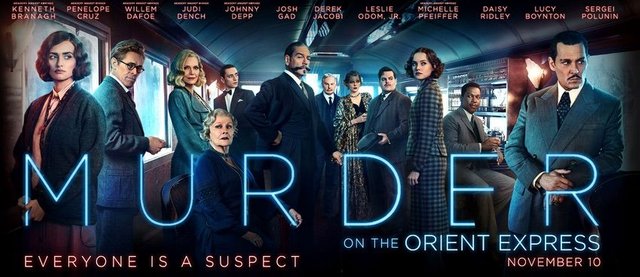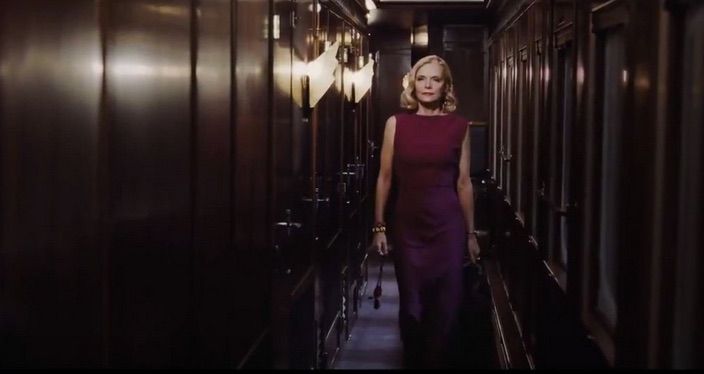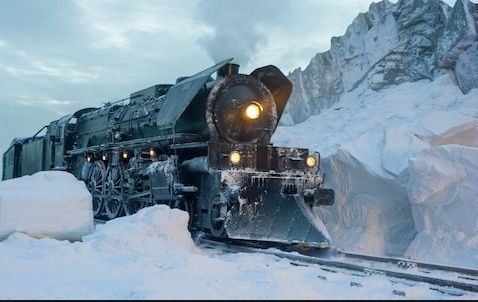
On black Friday my mom took me to the movies at a strip mall. It wasn’t as crowded as I feared. We went to see the new, improved “Murder on the Orient Express”, and after all those pre-preview commercials and six mushy previews (in the sense that I couldn’t tell what their movies were about), our movie began.
Kenneth Branagh directed and starred in “Murder on the Orient Express,” as the brilliant but twitchy Hercule Poirot. I have mixed feelings about Kenneth, but I liked what he did here—well, I liked his direction, his acting couldn’t touch David Suchet’s, still the best Poirot. And don’t worry, I won’t spoil the ending if you haven’t read or seen “Murder on the Orient Express”—I’ll just talk about the settings, costumes, and actors. (Settings, costumes, and props are where Kenneth Branagh shines—he’s still a stage director at heart, with a sharp eye for detail). The movie opened in Jerusalem, which was a pleasant surprise, then moved on to Istanbul via ferry—a gentle, slow transition device.
And now, the dramatis personae. This movie has an ensemble cast, with no weak links. Michelle Pfeiffer, Johnny Depp, Willem Dafoe, Penelope Cruz, Judi Dench, Daisy Ridley, Leslie Odom Jr., Josh Gad, Marwan Kenz, Olivia Colman, and Derek Jacobi make up the principals (besides Kenneth Branagh, who appears in almost every scene). As they filed onto the Orient Express in Istanbul, carrying their bags, lap dogs, and egos, I was reminded of some unseen hand loading up a chessboard. I won’t go through all the characters and their place in the script (or this review will run on for five pages), I’ll just say: see this movie if you like any one of those actors. And if you’ve been feeling let down by Johnny Depp lately, in this movie he’s a bad guy with a lot of layers—not as interesting as Edward Scissorhands, but far better than that goofy pirate he keeps reviving.
In a mystery, the objects are important: a dull black revolver, a burnt scrap of a letter, an embroidered handkerchief, a broken pocket watch, a red kimono, a china cup—all of these play a part. And they’re each interesting to look at, unique. The set is art deco, with beautiful wall sconces hanging off the dark wood walls of the cabins. The women wear lovely 1930s dresses, Mary Janes, marcel waves, and strategically placed brooches. The men wear classic suits and great coats, while Hercule Poirot (who is kind of androgynous, despite his murmurings to an old photograph of a lady) has that fabulous mustache and an elegant, useful cane.

Most of the action happens inside a small space—a train—next to a vast one: a high mountain pass in the Alps, where the train has been partially derailed by an avalanche. Branagh does a good job of building the claustrophobia: everyone is stuck in a tight space with a murderer while perched on a wooden bridge many thousands of feet high. The mountains are stark, just black and bluish white. It’s an excellent background for a play about the basest human emotions. Directly in the stalled train’s path: a black tunnel.

Even though I knew the plot and how it would end, I was still occasionally surprised by “Murder on the Orient Express”. There were novel camera angles—the murder scene shot from above, for instance—and damn, those gorgeous costumes. These took on a greater significance because everyone was pretending to be someone else. The only product placement that I caught was for Godiva chocolate, and it worked: I really wanted fancy chocolates by the end. Not to mention tiny espressos, aged brandy, and croissants—the food and drink was looking gourmet, all arranged just so on china plates in the dining car.
I only wish Kenneth Branagh had resisted giving himself a soliloquy, but I guess he’s still stuck in Hamlet mode (a role he played when he was 40, and Hamlet’s a college student). Hercule Poirot is not a man who talks to himself, but fine, at least it was a short monologue. Other than that scene, the movie moved along at a good clip, never rushed. The soundtrack was mostly background music that built climatically when the need arose. I liked the closing shot quite a bit: the sun rose pink and orange over the Orient Express, rolling out of its next mountain station, as Hercule Poirot leaves by rickety motor car, speeding off in the opposite direction.
If you enjoy murder mysteries, whether or not you know this story, go see it. Likewise if you’re into theater: the big reveal scene is set just like a Grecian proscenium, with burning torches behind the suspects seated at a table in the tunnel. Star rating: four out of five—and if I didn’t know the plot I might give it five.
Excellent review! Loved the imagery and how you set the scene and background for the actors and story line. You've convinced me to see this movie, even though I've seen other versions of it.
Downvoting a post can decrease pending rewards and make it less visible. Common reasons:
Submit